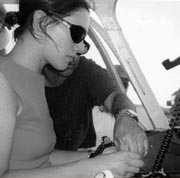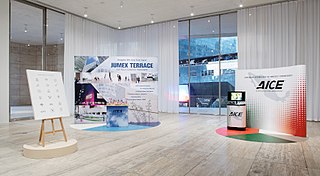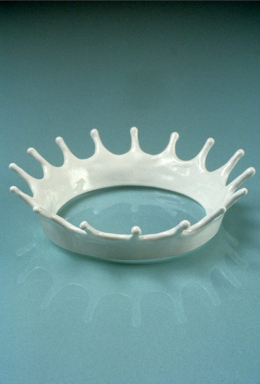
The Centre Pompidou, more fully the Centre national d'art et de culture Georges-Pompidou, also known as the Pompidou Centre in English, is a complex building in the Beaubourg area of the 4th arrondissement of Paris, near Les Halles, rue Montorgueil, and the Marais. It was designed in the style of high-tech architecture by the architectural team of Richard Rogers, Su Rogers and Renzo Piano, along with Gianfranco Franchini.
Carey Young is a visual artist whose work uses a variety of media including video, photography, text and installation. Her work often examines and questions the reach of the legal and commercial spheres and their ability to shape contemporary reality. Since 2017, she has created two films featuring female judges in order to examine the interrelationships of law, fiction and gender. Young teaches at the Slade School of Fine Art in London where she is a Professor in Fine Art.

Paweł Althamer is a Polish contemporary sculptor, performer, collaborative artist and creator of installations, and video art.

Amy Sillman is a New York-based visual artist, known for process-based paintings that move between abstraction and figuration, and engage nontraditional media including animation, zines and installation. Her work draws upon art historical tropes, particularly postwar American gestural painting, as both influences and foils; she engages feminist critiques of the discourses of mastery, genius and power in order to introduce qualities such as humor, awkwardness, self-deprecation, affect and doubt into her practice. Profiles in The New York Times, ARTnews, Frieze, and Interview, characterize Sillman as championing "the relevance of painting" and "a reinvigorated mode of abstraction reclaiming the potency of active brushwork and visible gestures." Critic Phyllis Tuchman described Sillman as "an inventive abstractionist" whose "messy, multivalent, lively" art "reframes long-held notions regarding the look and emotional character of abstraction."

Hannah Wilke (born Arlene Hannah Butter; was an American painter, sculptor, photographer, video artist and performance artist. Her work is known for exploring issues of feminism, sexuality and femininity.

Sarah Morris is an American and British artist. She lives in New York City in the United States.
Judy Fiskin is an American artist working in photography and video, and a member of the art school faculty at California Institute of the Arts. Her videos have been screened in the Documentary Fortnight series at the Museum of Modern Art in New York, at the Los Angeles County Museum of Art, the Hammer Museum in Los Angeles, and at the J. Paul Getty Museum in Los Angeles; her photographs have been shown at MOCA, the Museum of Contemporary Art in Los Angeles, at the Getty Museum in Los Angeles, at The New Museum in New York City, and at the Pompidou Center in Paris.

Elizabeth Murray was an American painter, printmaker and draughtsman. Her works are in many major public collections, including those of the Solomon R. Guggenheim Museum, the Hirshhorn Museum and Sculpture Garden, the Pérez Art Museum Miami, the Museum of Modern Art, the Whitney Museum of American Art, the San Francisco Museum of Modern Art, the Art Institute of Chicago, the Carnegie Museum of Art, and the Wadsworth Atheneum. Murray was known for her use of shaped canvases.

Anri Sala is an Albanian contemporary artist whose primary medium is video.

Michael Smith is an American artist known for his performance, video and installation works. He emerged in the mid-1970s at a time when performance and narrative-based art was beginning to claim space in contemporary art. Included among the Pictures Generation artists, he also appropriated pop culture, using television conventions rather than tropes from static media. Since 1979, much of Smith's work has centered on an Everyman character, "Mike," that he has portrayed in various domestic, entrepreneurial and artistic endeavors. Writers have described his videos and immersive installations as "poker-faced parodies" that sit on the edge between art and entertainment, examining ideas, cultural shifts and absurdities involving the American dream, consumerism, the art world, and aging. Village Voice critic Jerry Saltz called Smith "a consummate explorer of the land of the loser … limning a fine line between reality and satire [in] a genre sometimes called installation verité."

Lynda Benglis is an American sculptor and visual artist known especially for her wax paintings and poured latex sculptures. She maintains residences in New York City, Santa Fe, New Mexico, Kastellorizo, Greece, and Ahmedabad, India.
David Reed is a contemporary American conceptual and visual artist.

Jessica Stockholder is a Canadian-American artist known for site-specific installation works and sculptures that are often described as "paintings in space." She came to prominence in the early 1990s with monumental works that challenged boundaries between artwork and display environment as well as between pictorial and physical experience. Her art often presents a "barrage" of bold colors, textures and everyday objects, incorporating floors, walls and ceilings and sometimes spilling out of exhibition sites. Critics suggest that her work is informed by diverse artistic traditions, including abstract expressionism, color field painting, minimalism and Pop art. Since her early career, they have noted in her work an openness to spontaneity, accident and marginality and a rejection of permanency, monetization and disciplinary conventions that Stephen Westfall characterized as an "almost shocking sense of freedom."

Jennifer Bolande is an American postconceptual artist. Her art explores affinities and shifts of meaning among sets of objects and images across different contexts and media including sculpture, photography, film and installation. She emerged in the early 1980s with work that expanded on ideas and strategies rooted in conceptualism, Pop, Arte Povera and the so-called Pictures Generation. Her work focuses on thresholds, liminal and peripheral spaces, and transitional moments—states she enacts by the repetition, accumulation and recontextualization of found materials. She frequently selects cultural artifacts on the verge of obsolescence or in flux—and thus acquiring new meanings—and archives, studies and reframes them. Artforum critic Paula Marincola wrote, "Bolande's highly individualized amalgam of sculpture and photography proceeds obliquely but precisely toward an accumulation of possible meanings. She is a connoisseur of unlikely but evocative details, of subliminally perceived, fragmentary images and events."
Angela Washko is an American new media artist and facilitator based in New York. After nine years as a professor of art at Carnegie Mellon University, she is currently the Catherine B. Heller Collegiate Professor of Art at University of Michigan. Washko mobilizes communities and creates new forums for discussions of feminism where they do not exist.
Kevin Larmon is an American artist and was assistant monitor of painting at Syracuse University.

Gretchen Bender was an American artist who worked in film, video, and photography. She was from the so-called 1980s Pictures Generation of artists, which included Cindy Sherman, Robert Longo, Jack Goldstein, Laurie Simmons and Richard Prince, and who mixed elements of Conceptual Art and Pop Art using images from popular culture to examine its powerful codes.
Cindy Bernard is a Los-Angeles based artist whose artistic practice comprises photography, video, performance, and activism. In 2002, Cindy Bernard founded the Society for the Activation of Social Space through Art and Sound, which presents site-relational experimental music. Her numerous Hitchcock references have been discussed in Dan Auiler's Vertigo: The Making of a Hitchcock Classic (1998), essays by Douglas Cunningham and Christine Spengler in The San Francisco of Alfred Hitchcock's Vertigo: Place, Pilgrimage and Commemoration (2012) and Spengler's Hitchcock and Contemporary Art (2014).

Judith Barry is an American multimedia artist, writer and educator. Art critics regard her as a pioneer in performance art, video, electronic media and installation art who has contributed significantly to feminist theories of subjectivity and the exploration of public constructions of gender and identity. Her work draws on a diverse background, which includes studies in critical theory and cinema, dance, and training in architecture, design and computer graphics. Rather than employ a signature style, Barry combines multiple disciplines and mediums in immersive, research-based works whose common methodology calls into question technologies of representation and the spatial languages of film, urbanism and the art experience. Critic Kate Linker wrote, "Barry has examined the effects and ideological functions of images in and on society. Her installations and writings … have charted the transformation of representation by different 'machines' of image production, from the spatial ensembles of theater to computer and electronic technologies."
Carole Ann Klonarides is an American curator, video artist, writer and art consultant that has been based in New York and Los Angeles. She has worked in curatorial positions at the Santa Monica Museum of Art (1997–2000) and Long Beach Museum of Art (1991–95), curated exhibitions and projects for PS1 and Museum of Modern Art (MOMA), Laforet Museum (Tokyo), and Video Data Bank, among others, and been a consultant at the Getty Research Institute. Klonarides emerged as an artist among the loosely defined Pictures Generation group circa 1980; her video work has been presented in numerous museum exhibitions, including "Video and Language: Video As Language", "documenta 8," "New Works for New Spaces: Into the Nineties,", and "The Pictures Generation, 1974-1984", and at institutions such as MoMA, the Smithsonian Hirshhorn Museum, Contemporary Arts Center, the New Museum, The Kitchen, and School of the Art Institute of Chicago (2016). Her work belongs to the permanent collections of MoMA, the Whitney Museum of American Art, Getty Museum, Centre Pompidou, Contemporary Arts Museum Houston, Museu-Fundacão Calouste Gulbenkian (Lisbon), Museo Nacional Centro de Arte Reina Sofía (Madrid), and National Gallery of Canada, and is distributed by the Video Data Bank and Electronic Arts Intermix (EAI).
















